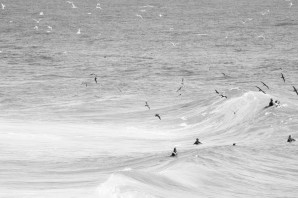

Shearwaters fish for bait fish, while surfers wait for waves at Duranbah on the Gold Coast. The shearwaters have flown from Alaska on their annual migration and many are starving and exhausted. If they can’t get a feed they become too weak to continue to their southern nesting grounds
The wreck of thousands of migrating mutton birds on Gold Coast beaches left a lot of residents wondering why.
On the worst days in October and November, early birds doing their morning beach walk would pass a dead bird every few meters – more like a Hells Highway of bird corpses than the famed glitter strip.
Thousands were lost this year, so many that the GCCC had to employ a truck to clean them up.
It wasn’t the first time though, there were thousands of deaths in 2009 and another big wreck in 2000.
This spring, reports of wrecks in October and November came from as far north as Double Island Point all the way to the shearwaters’ southern nesting grounds in the Tasman Sea.
Most people were shocked by the scale of the shearwater losses and like me had no idea what the cause was. They were just left to guess.
But when you learn what these bird have been through it’s not hard to understand why they run such a high risk of dying of exhaustion and hunger.
By the time the unfortunate mutton birds wash up starving and exhausted on the beach – they have flown 30,000 km from their nesting grounds in Bass Strait to Siberia and Alaska and back. The adults left in April and returned in September. The new chicks followed a few weeks later navigating only on instinct.
The main flocks came back through the Gold Coast in September, creating beautiful spectacles by flying low in massive magnificent Vs across the sea. The stragglers in October and November were mainly non-breeding age birds (younger than five). Some of them had lost 80 percent of their body weight on the flight south from the northern icy regions. Some were so hungry they dropped from a healthy 650 grams to only 150 grams. Many of them were first timers on the epic migration, less than a year old, and became so food deprived that their organs started failing, yet they flew until they literally dropped.
“They’ve got a natural imperative to get back to their breeding grounds,” said retired biodiversity planner Philip Du Guesclin, who studies a shearwater nesting ground near his house in the Southwest Victorian coastal town of Port Fairy, “They tend not to muck around.”
“It’s just part of the circle of life,” Currumbin Wildlife Hospital veterinary nurse, Ellen Richmond said of the deaths.
Ms Richmond and the team at the Currumbin Wildlife Hospital received over 300 stranded mutton birds during the weeks of the wrecks.
“They were coming in by the tubful. In one day we received a hundred.”
She estimated three quarters of the 300 were beyond help and euthanized. Only a quarter were assessed as viable and of them only a tiny four survived to be released successfully.
That is four more, however, than Phillip Du Guesclin would have expected, as he said it’s virtually impossible to nurse shearwaters back to health.
A little tip if you want to help a feathered friend though: You can just put them under a shady tree so they don’t dehydrate so quickly. Or if you find one and want to nurse it – don’t try to put water in its beak or force food on them, the best thing is offer it some fish, though there is next to no chance it will be strong enough to eat it, and get them to the animal hospital as soon as possible.
At the Currumbin Wildlife Hospital the viable ones were stomach tubed. It’s the only safe way to deliver the hydration and nutrition they desperately need.
“When they came in they were too weak to eat, so we have to stomach tube them,” Ms Richmond said.
The aim of the treatment was to get their weight up quickly without holding them so long that it would interfere with nature.
“We tried to hold them no longer than a week as they can lose the waterproofing on their feathers or miss the migration.”
The four that the Currumbin Wildlife Hospital released were nursed for about two weeks to make sure all four were ready to go together.
“They were little fatties, quite active, running around our waterbird rehab facility. They’d come up to peck your shoe laces,” the vet nurse said.
Down at Port Fairy at the nesting ground on Griffiths Island, there are currently about 100,000 burrows with birds sitting on eggs. Shearwaters mate for life and share parenting duties.
Phillip Du Guesclin won’t know what impact this spring’s wreck has had on the numbers until April when adults leave the nestlings in the nest. Then his team of volunteers will be able to do a count.
“It (the recent wreck) is not a great concern, but it depends on how often it happens,” he said.
He said that as shearwaters are the most globally abundant avian species, observing what is happening with them could provide insights into what problems are facing more threatened bird species.
The mutton birds could be the early warning system like the “canary in the cage,” he said.
Scientist Dr Grainne Maguire who is the Project Manager of Beach-nesting Birds from Birdlife Australia has called for interested people to try and record numbers of dead and dying shearwaters on beaches.
“The wreck of Short-tailed Shearwaters appears particularly abundant along the Australian coast this spring,” she said.
Like many early birds on their beach walk Dr Maguire couldn’t say with certainty if there is something more than the cycle of nature behind so many dead birds.
It seems more widespread but “unless we collect data and do this consistently, this is only an observation,” she said.
